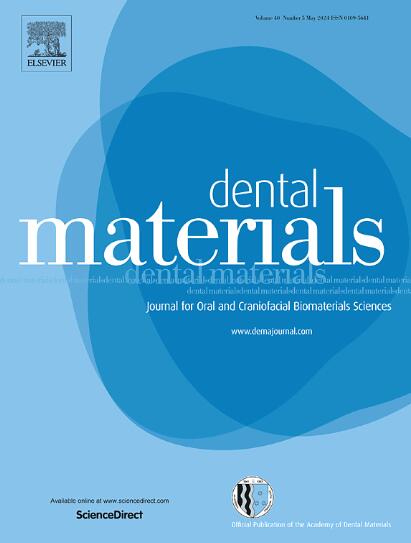The effects of optimized microstructured surfaces on bond strength and durability of NPJ-printed zirconia
IF 4.6
1区 医学
Q1 DENTISTRY, ORAL SURGERY & MEDICINE
引用次数: 0
Abstract
Objectives
This study was to investigate the effects of optimized microstructured surfaces on bond strength and bond durability of the latest nanoparticle jetting (NPJ)-printed zirconia.
Methods
Zirconia microstructured surfaces with different geometries and void volume were analyzed through three-dimensional finite element analysis for surface micromorphology optimization. Zirconia disks and cylinders were additively manufactured by an NPJ 3D printer (N = 128). They were randomly divided into four groups based on surface micromorphology optimization and airborne-particle abrasion (APA) treatment before they were bonded using 10-methacryloloxydecyl dihydrogen phosphate (MDP) containing resin cement (Clearfil SA luting cement). The shear bond strengths (SBSs) were tested before and after 10,000 thermocycles and were analyzed by one-way ANOVA analysis. Failure modes were determined by optical microscopy. Zirconia surfaces were analyzed with X-ray diffraction, scanning electron microscopy, and three-dimensional interference microscopy.
Results
The optimized microstructured surface was characterized by circular microstructures with 60 % void volume, about 20 µm of depths, about 10 µm of undercuts, and consistent beam widths. The optimized microstructured surface combined with APA treatment and MDP-containing resin cement possessed the highest SBSs both before and after thermocycling aging (P<0.05). The greater reductions of zirconia bond strengths occurred when the zirconia were not treated with APA (P<0.05).
Significance
The optimized microstructured zirconia surface with circular microstructures and 60 % void volume fabricated by the latest NPJ printing technology could greatly enhance the zirconia bond strength and durability in combination with APA treatment and application of MDP-containing resin cement, which might be promising for adhesively bonded indirect restorations of NPJ-printed zirconia.
优化微结构表面对 NPJ 印刷氧化锆粘接强度和耐久性的影响。
研究目的本研究旨在探讨优化的微结构表面对最新的纳米粒子喷射(NPJ)印刷氧化锆的粘接强度和粘接耐久性的影响:方法:通过三维有限元分析对不同几何形状和空隙量的氧化锆微结构表面进行分析,以优化表面微观形态。氧化锆圆盘和圆柱体由 NPJ 三维打印机(N = 128)添加制造而成。在使用含 10-甲基丙烯酰氧癸基磷酸二氢酯(MDP)的树脂水门汀(Clearfil SA 树脂水门汀)进行粘接之前,根据表面微观形态优化和气载颗粒磨损(APA)处理将它们随机分为四组。对 10,000 次热循环前后的剪切粘接强度(SBS)进行了测试,并通过单因素方差分析进行了分析。失效模式由光学显微镜确定。用 X 射线衍射、扫描电子显微镜和三维干涉显微镜分析氧化锆表面:优化后的微结构表面具有圆形微结构,空隙率为 60%,深度约为 20 µm,下切深度约为 10 µm,束宽一致。结合 APA 处理和含 MDP 树脂水泥的优化微结构表面在热循环老化前后都具有最高的 SBS(P<0.05)。未经 APA 处理的氧化锆的结合强度降低幅度更大(P<0.05):意义:利用最新的 NPJ 印刷技术制作的具有圆形微结构和 60% 空隙体积的优化微结构氧化锆表面,与 APA 处理和含 MDP 树脂水门汀结合使用,可大大提高氧化锆的粘结强度和耐久性,有望用于 NPJ 印刷氧化锆的粘结间接修复。
本文章由计算机程序翻译,如有差异,请以英文原文为准。
求助全文
约1分钟内获得全文
求助全文
来源期刊

Dental Materials
工程技术-材料科学:生物材料
CiteScore
9.80
自引率
10.00%
发文量
290
审稿时长
67 days
期刊介绍:
Dental Materials publishes original research, review articles, and short communications.
Academy of Dental Materials members click here to register for free access to Dental Materials online.
The principal aim of Dental Materials is to promote rapid communication of scientific information between academia, industry, and the dental practitioner. Original Manuscripts on clinical and laboratory research of basic and applied character which focus on the properties or performance of dental materials or the reaction of host tissues to materials are given priority publication. Other acceptable topics include application technology in clinical dentistry and dental laboratory technology.
Comprehensive reviews and editorial commentaries on pertinent subjects will be considered.
 求助内容:
求助内容: 应助结果提醒方式:
应助结果提醒方式:


